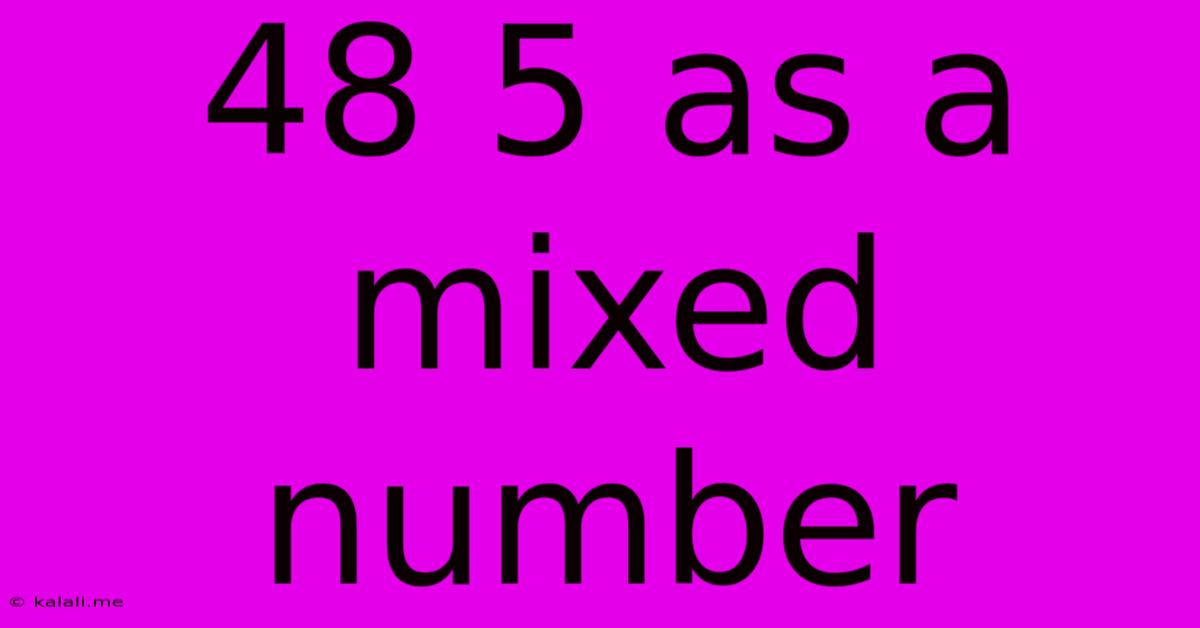48 5 As A Mixed Number
Kalali
May 09, 2025 · 2 min read

Table of Contents
48/5 as a Mixed Number: A Step-by-Step Guide
Understanding how to convert improper fractions, like 48/5, into mixed numbers is a fundamental skill in mathematics. This simple yet crucial concept helps simplify complex fractions and makes them easier to visualize and work with. This article will guide you through the process of converting 48/5 into a mixed number, explaining the steps involved and providing you with a solid understanding of the underlying principles.
What is a Mixed Number?
A mixed number combines a whole number and a proper fraction. A proper fraction is one where the numerator (top number) is smaller than the denominator (bottom number). For example, 2 ¾ is a mixed number: 2 is the whole number, and ¾ is the proper fraction.
Converting 48/5 to a Mixed Number
To convert 48/5 into a mixed number, we need to determine how many times 5 goes into 48 and what the remainder is. We can do this through division:
-
Divide the numerator by the denominator: 48 ÷ 5 = 9 with a remainder of 3.
-
The quotient becomes the whole number: The quotient, 9, becomes the whole number part of our mixed number.
-
The remainder becomes the numerator of the proper fraction: The remainder, 3, becomes the numerator of the proper fraction.
-
The denominator remains the same: The denominator, 5, stays the same in the proper fraction.
Therefore, 48/5 as a mixed number is 9 3/5.
Understanding the Process
The division process essentially breaks down the improper fraction into its whole number and fractional components. Each '5' in the division represents a whole unit. Nine '5's fit perfectly into 48, leaving 3 remaining, which represents the fractional part of the whole.
Practical Applications
Converting improper fractions to mixed numbers is frequently used in various applications:
- Measurement: When dealing with measurements like inches, feet, or meters, mixed numbers often provide a more intuitive representation than improper fractions.
- Baking and Cooking: Recipes often use mixed numbers to represent quantities of ingredients.
- Construction and Engineering: Mixed numbers are commonly used in calculations involving dimensions and quantities.
Other Examples
Let's quickly look at a couple of other examples to solidify your understanding:
- Converting 22/7 to a mixed number: 22 ÷ 7 = 3 with a remainder of 1. Therefore, 22/7 = 3 1/7.
- Converting 17/3 to a mixed number: 17 ÷ 3 = 5 with a remainder of 2. Therefore, 17/3 = 5 2/3.
Mastering the conversion of improper fractions to mixed numbers is essential for a strong foundation in mathematical understanding and problem-solving. By following the simple steps outlined above, you can confidently handle these types of conversions in various real-world scenarios. Remember to practice regularly to build your proficiency!
Latest Posts
Related Post
Thank you for visiting our website which covers about 48 5 As A Mixed Number . We hope the information provided has been useful to you. Feel free to contact us if you have any questions or need further assistance. See you next time and don't miss to bookmark.